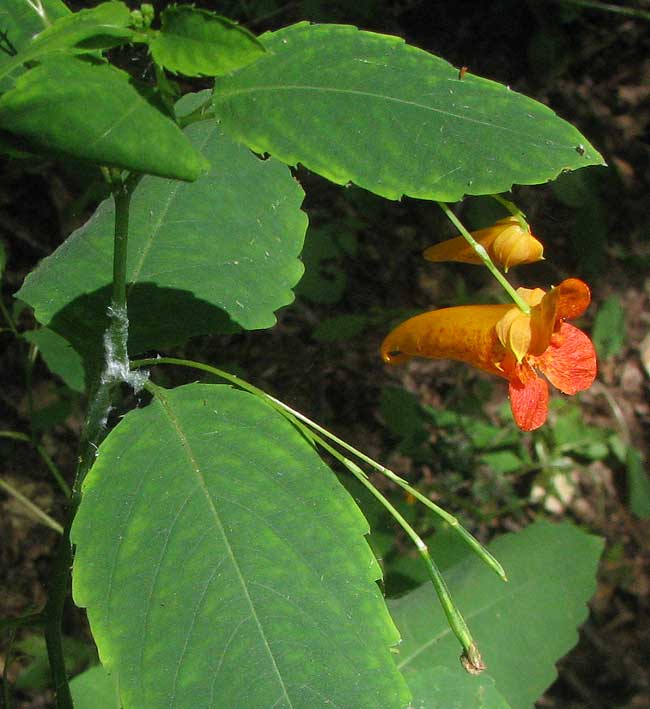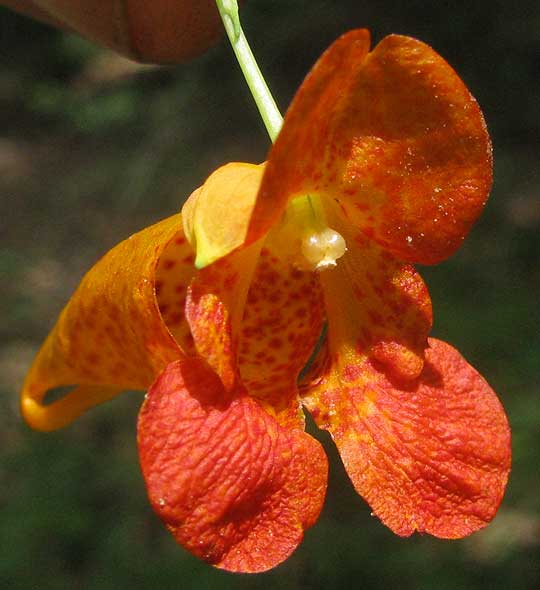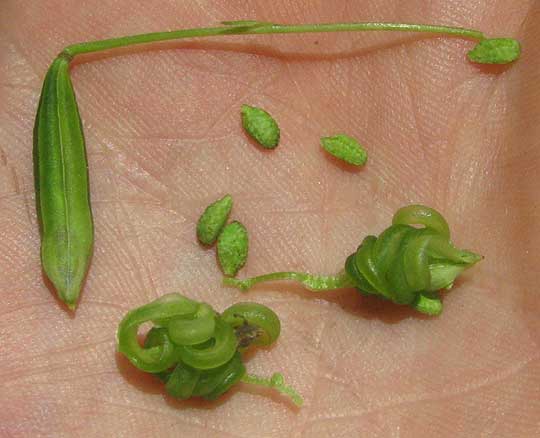Excerpts from Jim Conrad's
Naturalist Newsletter

from the the May 13, 2012 Newsletter issued from the woods of the Loess Hill Region a few miles east of Natchez, Mississippi, USA
ORANGE TOUCH-ME-NOTS
Deep in a shadowy swamp beside standing water with knobby Baldcypress knees rising nearby, a narrow shaft of light highlighted what's shown above.
That's the Orange Touch-me-not, also called Orange Jewelweed, IMPATIENS CAPENSIS. With such an unusual blossom you might guess that touch-me-nots belong to a smallish family, and that's the case. It's the Balsam Family, Balsaminaceae, comprising only two genera and about 850 species of soft or succulent herbs. A distinguishing feature of the family is that its flowers have three sepals -- the calyx lobes subtending the corolla and sexual parts -- with one of those sepals being tremendously enlarged into a backward-projecting "honey-spur." The honey-spur is a baglike structure holding nectar for pollinators. Hummingbirds are especially attracted to the flowers, as well as bees and butterflies. In the above image you can clearly see two yellowish sepals atop the orange corolla, and the orange third sepal, the honey-spur, behind the flower's opening. A close-up of the front showing the flower's five petals is shown below:

The pale items suspended from the blossom's "ceiling" and slightly projecting beyond the throat are part of five stamens with short, flat, grown-together filaments and anthers.
Touch-me-not fruits are as remarkable as the flowers because they're explosive. Touch a mature fruit and the capsule instantly ruptures, its five elongate, elastic sides coiling into knots so fast that seeds are thrown in all directions. That's why they're called touch-me-nots. You can see an unexploded fruit with two exploded ones and some ejected seeds below:

When I come onto a large colony of touch-me-nots I enjoy picking fruits, exploding them in my closed hand so that the seeds don't escape, and snacking on the seeds, which have a nice, nutty flavor.
In the US Southeast we have two native, wild touch-me-not species, of which the Orange is one. The other species is practically identical, except that its flowers are yellow. The Yellow Touch-me-not doesn't occur in Mississippi but at my childhood home in Kentucky sometimes both the Yellow and Orange species occurred in the same area, not interbreeding. Orange Touch-me-nots occur throughout North America's forested areas, except for the northernmost and arid regions.
Juice from touch-me-not stems is used to relieve itching from Poison Ivy and for treatment of athlete's foot. In fact the juice contains a compound called lawsone proven to have anti-histamine and anti-inflammatory properties, plus studies confirm that it's fungicidal.